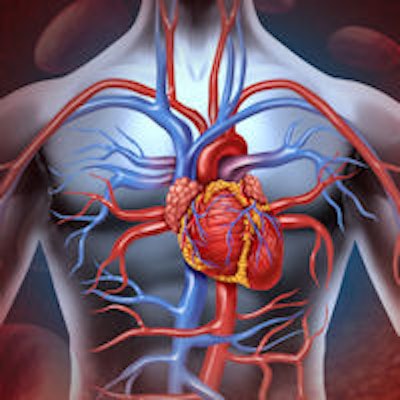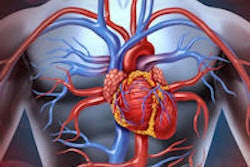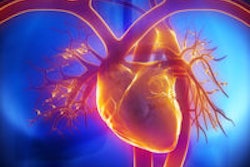
The routine use of coronary CT angiography (CCTA) rather than nuclear cardiac scans for the initial evaluation of patients with stable chest pain is "reasonable," concludes a just-published analysis of two large studies in the Journal of the American College of Cardiology.
In their analysis, researchers from Duke University and the University of Edinburgh in Scotland parsed the results of SCOT-HEART (Scottish Computed Tomography of the Heart) and PROMISE (Prospective Multicenter Imaging Study for Evaluation of Chest Pain), looking for insight into improving the diagnosis and management of patients with stable chest pain.
CCTA showed several benefits for initial patient workup, benefits that increased when it was performed concurrently with exercise treadmill testing (ETT) with an electrocardiogram (ECG). In patients lacking contraindications to specific exams, clinicians should consider both functional and anatomic imaging, the group concluded.
"I think CCTA comes out as a really reasonable option for patients at intermediate risk of having obstructive coronary disease as the cause of their chest pain," said corresponding author Dr. Christopher Fordyce, a cardiovascular disease fellow at Duke, in an interview with AuntMinnie.com. "Today people have the option to choose CT or functional, and I think we should be considering both."
Of course, these changes would require re-evaluation of current U.S. guidelines, which recommend ETT as the first test, with CCTA reserved for patients who cannot undergo stress testing, wrote Fordyce along with Dr. Pamela Douglas from Duke Clinical Research Institute and Dr. David Newby, PhD, from the University of Edinburgh (JACC, February 23, 2016, Vol. 67:7, pp. 843-852).
U.S. clinical practice, which "skews toward the use of stress radionuclide imaging as the first test," would also have to change, they added.
Big problem
Angina is common in an aging population. Four million exercise stress tests each year in the U.S. attest to its prevalence, but one-third of individuals diagnosed with noncardiac chest pain subsequently die of cardiovascular disease, a clear indication that diagnostic strategies need improvement, the team wrote. Most trials have focused on the accuracy of testing modalities or their effect on patient management.
"However, few (if any) randomized studies directly compared the various anatomic and functional testing options in patients with stable chest pain using clinical end points," the authors wrote.
There are differences to clinical approaches in the U.S. and Europe and within Europe itself, but there is little consensus worldwide on which test is preferred because of the dearth of outcomes data.
Considering outcomes
The two analyzed trials, SCOT-HEART and PROMISE, aimed to bridge the outcomes evidence gap in the noninvasive evaluation of stable chest pain. They have similarities, but the studies address different populations in different ways.
The single-center SCOT-HEART trial included 4,146 patients with stable chest pain and usual care. The trial relied on diagnostic thinking to attribute symptoms to coronary disease, which showed an increase in the CCTA group (relative risk, 1.79). A secondary end point gauged the certainty of diagnosis. Death and the myocardial infarction rate were lower at 20 months (relative risk, 0.62) with CCTA versus the usual care group, although event rates were low in both arms.
In SCOT-HEART, the overall rate of all-cause death and nonfatal myocardial infarction was 2.3% with a median follow-up of 1.7 years. The overall rate of the same end points in PROMISE was similar: 2.2% at 2.1 years.
The larger multicenter PROMISE trial randomly assigned 10,003 symptomatic, stable outpatients needing evaluation to CCTA or functional stress testing, with a median follow-up of 25 months. Most participants (85%) had already undergone treadmill stress testing.
In PROMISE, a composite primary end point for events was lower than historical rates. More CCTA patients had cardiac catheterization (12.2% versus 8.1% for functional stress testing). The frequency of catheterization showing no obstructive disease was significantly lower in the CCTA group at 3.2% than with functional stress testing (6.2%). Radiation doses were significantly lower with CCTA than functional testing.
The radiation dose advantage with CCTA "is particularly intriguing, because more CCTA patients received cardiac catheterization," the authors wrote.
Both trials had similar rates of invasive coronary angiography -- 12% within six weeks (SCOT-HEART) or 12% at 90 days (PROMISE). In both, CCTA was associated with increased use of percutaneous coronary intervention and coronary artery bypass surgery.
The study design allowed SCOT-HEART to evaluate changes in diagnostic thinking, "including changes in diagnostic certainty and frequency and in plans for testing and subsequent care within the CCTA arm," the authors wrote. "In contrast, outcomes in PROMISE were on the basis of long-term comparisons of clinical events."
Patients with stable chest pain are at low risk of clinical events, regardless of the choice of diagnostic test, the authors concluded. They confirmed that patients with stable chest pain are at lower risk for clinical events than previously thought, despite having a pretest probability of obstructive disease according to traditional risk-scoring systems.
Two-thirds of all noninvasive imaging tests for suspected coronary disease are negative or represent nonobstructive disease, the group noted.
How to examine patients
The SCOT-HEART results favor the combination of treadmill testing followed by CCTA as a first-line diagnostic strategy that enhances certainty and shows a trend toward reducing cardiac events over treadmill tests alone.
CCTA may be favored if additional CT imaging is required, such as a triple rule-out study for suspected pulmonary embolism or aortic dissection. It may also be favored if an intrathoracic pathology such as pericardial disease is suspected, or if CT is expected to alter patient management, the team wrote.
Stress echocardiography or cardiac MR might be preferred in a highly radiosensitive population, or when valvular, pericardial, or congenital abnormalities are suspected. ETT alone might be enough in a radiosensitive population or to cut costs in a very low-risk population, the authors wrote.
"These are more nuanced choices" that doctors can make, Fordyce said. "When are you going to choose one or the other? If you're seeing a patient and you're worried they might also have valvular disease and they're short of breath, don't do a CCTA, get an echo. Or if they're young, maybe they're female and they're having chest pain, you may want to shy away from a nuclear scan where you're going to expose them to radiation. Maybe you want a treadmill if your pretest probability is on the lower limit. It's sort of to say we can be a little bit thoughtful now that we can order either/or."
Fractional flow reserve CT (FFRCT) is going to be a useful tool going forward because it can provide information on obstructive disease and ischemia in a single CT exam, he added.
Finally, a study presented at the American College of Cardiology meeting last year found that CCTA costs are reasonable in that it doesn't find excessive disease that drives up costs and procedure numbers, Fordyce said.



















